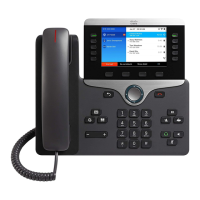Usage notesPurposeNetwork protocol
To communicate using IP, network devices
must have an assigned IP address, subnet,
and gateway.
IP addresses, subnets, and gateway
identifications are automatically assigned
if you are using the Cisco IP Phone with
Dynamic Host Configuration Protocol
(DHCP). If you are not using DHCP, you
must manually assign these properties to
each phone locally.
IP is a messaging protocol that addresses
and sends packets across the network.
Internet Protocol (IP)
The Cisco IP Phone supports LLDP on the
PC port.
LLDP is a standardized network discovery
protocol (similar to CDP) that is supported
on some Cisco and third-party devices.
Link Layer Discovery Protocol (LLDP)
The Cisco IP Phone supports LLDP-MED
on the SW port to communicate information
such as:
• Voice VLAN configuration
• Device discovery
• Power management
• Inventory management
For more information about LLDP-MED
support, see the LLDP-MED and Cisco
Discovery Protocol white paper:
http://www.cisco.com/en/US/tech/tk652/tk701/technologies_white_paper0900aecd804cd46d.shtml
LLDP-MED is an extension of the LLDP
standard for voice products.
Link Layer Discovery Protocol-Media
Endpoint Devices (LLDP-MED)
Cisco IP Phones use the RTP protocol to
send and receive real-time voice traffic
from other phones and gateways.
RTP is a standard protocol for transporting
real-time data, such as interactive voice,
over data networks.
Real-Time Transport Protocol (RTP)
RTCP is disabled by default.RTCP works in conjunction with RTP to
provide QoS data (such as jitter, latency,
and round-trip delay) on RTP streams.
Real-Time Control Protocol (RTCP)
SDP capabilities, such as codec types,
DTMF detection, and comfort noise, are
normally configured on a global basis by
Third-Party Call Control System or Media
Gateway in operation. Some SIP endpoints
may allow configuration of these
parameters on the endpoint itself.
SDP is the portion of the SIP protocol that
determines which parameters are available
during a connection between two endpoints.
Conferences are established by using only
the SDP capabilities that all endpoints in
the conference support.
Session Description Protocol (SDP)
Cisco IP Phone 8800 Series Multiplatform Phones Administration Guide
20
About the Cisco IP Phone
Network Protocols

